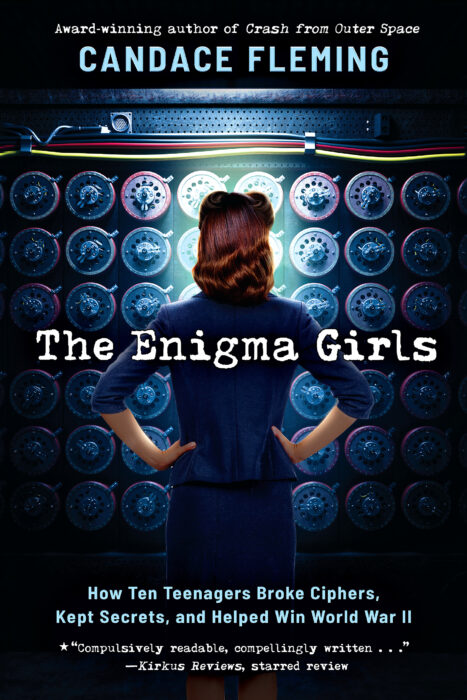 The Enigma Girls: How Ten Teenagers Broke Ciphers, Kept Secrets, and Helped Win World War II
The Enigma Girls: How Ten Teenagers Broke Ciphers, Kept Secrets, and Helped Win World War II
Written by Candace Fleming
Scholastic Focus, 2024, 371 pp
ISBN: 9781338749571
The setting is England as Hitler breaks promises and spreads his power over more of continental Europe. It is clear he wants to extend his reach across the English Channel. The question for Winston Churchill and other world leaders is, How do we stop him? Their answer is to find out his plans and movements so the Allied forces can strike effectively and cripple his plans. Enter Bletchley Park, a top secret center about 50 miles outside of London. This is where the British government collected an army of people who worked 24 hours a day decoding and deciphering messages collected from the airwaves by listeners scattered across the coastline. Some of them are well known, like Alan Turing who famously developed an early form of computer that could break the Enigma code. The code was the product of an almost unbreakable coding machine that allowed the Nazis to communicate their secret plans. The Enigma Machine had four wheels that were reset every 24 hours, so even if someone broke the code one day, it changed the next. Even with Turing’s computer, it took an army of people to listen, collect, run the Bombas (the name given to Turing’s code-breaking computer), check and translate the message, catalog and cross-reference it to look for patterns in the communication, and then pass on the information to the military decision-makers. Many of those who did this work were teenage girls, recruited because they could speak other languages or had performed well in school.
Candace Fleming’s account of these girls emphasizes the secrecy of what they were doing and their sheer dedication for the war effort. Each person at Bletchley Park had to sign a document promising never to speak to anyone, including their co-workers, about their work, and they were to keep this promise for the rest of their lives. The intent was to create silos where the girls understood their task but did not understand how they contributed to the whole war effort. However, they did understand their work contributed to saving lives and willingly worked long shifts in less than ideal conditions. Once the British government released documents in the 1970’s about the work done at Bletchley Park, the workers were then free to tell their families what they did during WWII.
The book chronicles ten of the teens who worked in various roles at Bletchley Park. Fleming’s account, like all of her nonfiction, is well-researched with copious source notes and bibliographies. She skillfully weaves in the girls’ personalities, so the book reads like a movie script with action and suspense. The book is heavily illustrated with historic photographs, lending authenticity to the story. Fleming’s narratives of the teens are based on books and memoirs they wrote once they were permitted to talk about their war work.
While Fleming’s book focuses on the technology, the human skill of breaking the codes and understanding the communications between Hitler and his military forces, it also includes descriptions of how the British misdirected the German forces, including feeding double agents false information and dumping a body planted with false invasion plans that washed up on the Spanish shore. The plans were opened and decrypted by the Nazis before the documents were returned to the British.
Books pairing well with The Enigma Girls include titles emphasizing espionage in wartime, such as Bomb! The Race to Build and Steal the World’s Most Dangerous Weapon (Steve Sheinkin, 2012) or Code Name Verity (Elizabeth Wein, 2012). Another type of coded communication is portrayed in Code Talker: A Novel About the Navajo Marines of World War Two (Joseph Bruchac, 2005). Two other books featuring the Enigma Machine are the graphic novel The Imitation Game: Alan Turing Decoded (Jim Ottaviani and Leland Purvis, 2019) and the novel The Enigma Game (Elizabeth Wein, 2020). Finally the Bletchley Riddle, coming out in October 2024, is a historical fiction novel co-authored by Steve Sheinkin and Ruta Sepetys that highlights the mysterious work at Bletchley Park.
Candace Fleming is an award-winning author of historical nonfiction. She grew up telling stories and filling notebooks with imaginative tales and beautiful language. Then in college she discovered history. Writing historical accounts, like The Enigma Girls, demonstrates her linguistic skill at retelling true stories in a way that captures readers on page one and does not let them go until the final punctuation. She explains, “after all, some of the best stories are true ones — tales of heroism and villainy made more incredible by the fact they really happened.” More information about the 52 books (historical accounts, non-fiction texts, novels, and picturebooks) she has authored can be found on her website.
Susan Corapi, Trinity International University
© 2024 by Susan Corapi

WOW Review, Volume XVI, Issue 4 by Worlds of Words is licensed under a Creative Commons Attribution-NonCommercial-ShareAlike 4.0 International License. Based on work by Susan Corapi at https://wowlit.org/on-line-publications/review/xvi-4/8/
WOW review: reading across cultures
ISSN 2577-0527
